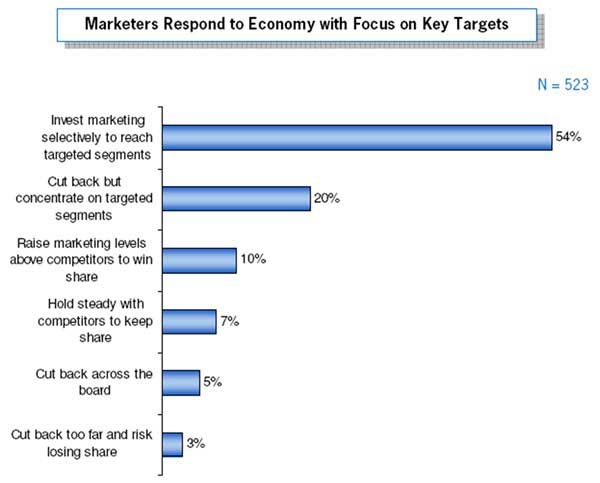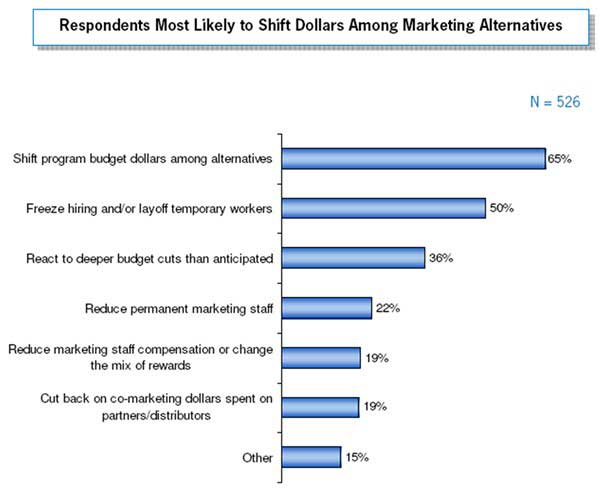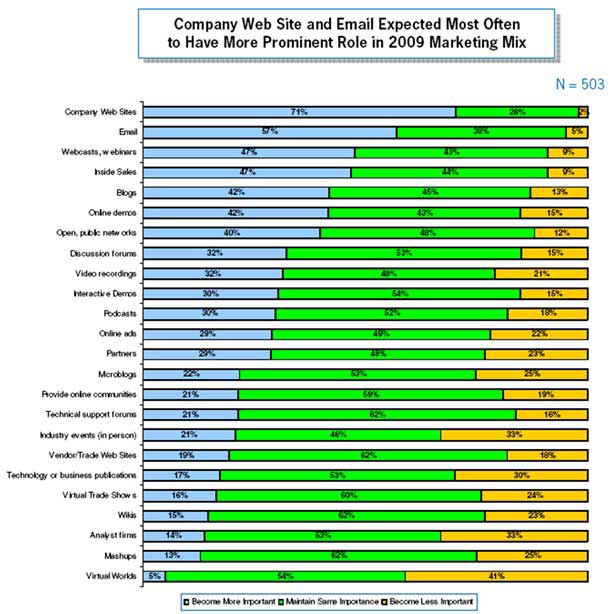The economic downturn has forced many B2B marketers to operate with smaller budgets and lower headcounts, with many opting to direct their efforts toward more narrowly defined targets, according to the recently published MarketingProfs report B2B Marketing in 2009: Trends in Strategies and Spending.
Survey participants were asked about the strategies they are using to deal with the economic downturn, what tactics they believe are most effective for them, and how their companies are likely to respond to new challenges.
Some 54% indicated that, in response to the recession, they planned to invest selectively to reach targeted segments and another 20% reported that, despite all-around cuts, they would focus on targeted segments. Very few (just 10%) indicated that they would increase marketing spending levels above those of competitors in an attempt to gain share:

Changes to Marketing Budgets for 2009
The survey responses indicated that 56% of large companies (annual revenue > $500 million) and 43% of medium-sized companies (annual revenue between $20 million and $499.9 million) expected decreases in their marketing budgets for 2009. Small companies (with annual revenues less than $20 million) were significantly more likely than large companies to anticipate budget increases for 2009 (31% of small companies anticipated increase vs. 16% of large companies).
When respondents were asked about how the economic situation would affect marketing dollars, 65% said that program dollars would be shifted among various alternatives and 50% said that their firms would institute hiring freezes or lay off temporary workers:

Key findings:
- The survey responses indicated that medium-sized ($20 million-$499.9 million in annual revenue) and large companies ($500 million-plus) were more likely than small companies (<$20 million) to consider an array of responses.
- Regarding their plans for investing in marketing technology in 2009, 39% of respondents reported adopting a fairly conservative course, preferring to follow the lead of others in their industry, while 31% reported themselves willing to adopt technologies and methods that had proven successful to those outside their own industry. Relatively few companies (12%) were reported to be planning to take a very aggressive approach, and a slightly larger proportion (18%) were unwilling to take any risks at all with marketing technology investment in 2009.
- Web 2.0 Integrators—companies that had integrated at least one Web 2.0 technology into their marketing mix—were significantly more likely than non-Integrators to report an aggressive company attitude toward investment in new marketing technology, perhaps because they had already utilized and grown comfortable with some technology-based marketing tactics.
Tactics and Trends for 2009
Traditional tactics such as trade shows and public relations still dominate the marketing mix, but digital tactics nevertheless play a major role: The top two tactics that B2B marketers said they planned to use in 2009 were company website (92%) and email (82%):

Respondents were asked to identify what tactics would play a greater role in 2009 compared with the year before. The tactic they cited most often was company website (71%):

Key findings:
- More than half (57%) of respondents reported that email would play a larger role in 2009 than in 2008. Some 47% said the same of webinars and inside sales, 42% said the same of blogs, and 40% said the same of open/public social networks.
- Respondents noted that they saw the influence of virtual worlds (e.g., Second Life) fading (41%). Given the fact that this digital tactic is a relatively new tool, it is not clear whether its importance is truly in decline, or if marketers are still evaluating its application to marketing.
- In another question, respondents were asked to rate specific tactics on their effectiveness at specific tasks compared with the year prior. For increasing brand awareness, email was considered to be more effective in 2008 than in 2007, earning an effectiveness rating of 25% in 2008, up from 19% the previous year. Ratings for search marketing increased slightly, from 23% to 24%.
- For lead generation, email garnered a modestly higher rating in 2008 than in 2007 (24% vs. 21%), but other digital marketing tactics were rated as less effective year over year: the effectiveness rating of online video in generating leads fell to 11% from 23%, online display ads fell from 10% in 2007 to 4% in 2008, and search marketing dropped from 30% to 26%.
- Compared with those B2B marketers who have not integrated Web 2.0 tactics already into their marketing mix, Web 2.0 Integrators plan to have many Web 2.0 tactics play a larger role in their marketing mix for 2009: Blogs (56%), open public networks (56%), discussion forums (40%), interactive demos (34%), microblogs (33%), private online communities (28%), and wikis (20%).
About the data: In late 2008, MarketingProfs and Forrester Research recruited marketing executives and other management professionals from the MarketingProfs membership and the Forrester business-to-business panel. 656 respondents were surveyed on a number of issues and questions related to current and anticipated marketing strategies, tactics, budget, attitudes, and administration, as well as current and predicted changes in response to economic conditions. The data collected are compiled in this report and compared with those gathered in late 2007 via a similar survey instrument.



